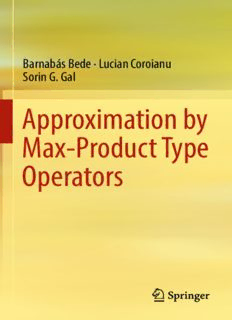Table Of ContentBarnabás Bede · Lucian Coroianu
Sorin G. Gal
Approximation by
Max-Product Type
Operators
Approximation by Max-Product Type Operators
Barnabás Bede (cid:129) Lucian Coroianu (cid:129) Sorin G. Gal
Approximation by
Max-Product Type Operators
123
BarnabásBede LucianCoroianu
DepartmentofMathematics DepartmentofMathematics
DigiPenInstituteofTechnology andComputerScience
Redmond,WA,USA UniversityofOradea
Oradea,Romania
SorinG.Gal
DepartmentofMathematics
andComputerScience
UniversityofOradea
Oradea,Romania
ISBN978-3-319-34188-0 ISBN978-3-319-34189-7 (eBook)
DOI10.1007/978-3-319-34189-7
LibraryofCongressControlNumber:2016940388
Mathematics Subject Classification (2010): 41A35, 41A20, 41A25, 41A27, 41A40, 41A29, 41A30,
41A05,94A12,47H10,28A80
©SpringerInternationalPublishingSwitzerland2016
Thisworkissubjecttocopyright.AllrightsarereservedbythePublisher,whetherthewholeorpartof
thematerialisconcerned,specificallytherightsoftranslation,reprinting,reuseofillustrations,recitation,
broadcasting,reproductiononmicrofilmsorinanyotherphysicalway,andtransmissionorinformation
storageandretrieval,electronicadaptation,computersoftware,orbysimilarordissimilarmethodology
nowknownorhereafterdeveloped.
Theuseofgeneraldescriptivenames,registerednames,trademarks,servicemarks,etc.inthispublication
doesnotimply,evenintheabsenceofaspecificstatement,thatsuchnamesareexemptfromtherelevant
protectivelawsandregulationsandthereforefreeforgeneraluse.
Thepublisher,theauthorsandtheeditorsaresafetoassumethattheadviceandinformationinthisbook
arebelievedtobetrueandaccurateatthedateofpublication.Neitherthepublishernortheauthorsor
theeditorsgiveawarranty,expressorimplied,withrespecttothematerialcontainedhereinorforany
errorsoromissionsthatmayhavebeenmade.
Printedonacid-freepaper
ThisSpringerimprintispublishedbySpringerNature
TheregisteredcompanyisSpringerInternationalPublishingAGSwitzerland
Dedicatedtoourlovelyfamilies
Preface
In this research monograph, we bring to light an interesting new direction in
constructiveapproximationoffunctionsbyoperators.
There are at least two natural justifications for these new operators, termed by
us as max-product operators (for reasons we will see below). They are based on
possibilitytheory,amathematicaltheorydealingwithcertaintypesofuncertainties
andwhichisconsideredasanalternativetoprobabilitytheory.
Thefirstjustificationisbasedontheinterpretationsofthemax-productBernstein
operator as a possibilistic expectation of a particular fuzzy variable having a
possibilisticBernoullidistributionandonaChebyshev-typeinequalityinthetheory
of possibility, facts which are in a perfect analogy with the probabilistic approach
ofBernsteinfortheconvergenceoftheclassicalBernsteinpolynomials.
ThesecondjustificationisbasedontheFellerschemeintermsofthepossibilistic
integral,whichagainisinperfectanalogywiththeclassicalFellers’sprobabilistic
schemeusedfortheconstructionoftheconvergentsequencesofpositiveandlinear
operators.
The generality of these two approaches allows us to obtain convergence results
for many discrete max-product-type operators, like the max-product Bernstein
operators, max-product Meyer–König and Zeller operators, max-product Favard–
Szász–Mirakjan operators, max-product Baskakov operators, max-product Picard
operators, max-product Gauss–Weierstrass operators, and max-product Poisson–
Cauchyoperators.
For these reasons, the max-product-type operators could also be called
possibilistic-typeoperators.
The method of directly obtaining the max-product operators can easily be
formalized as follows (see Open Question 5.5.4, p.324 in the book Gal [84]): for
example, in the case of the classical Bernstein polynomials, we write them in the
form
P
B .f/.x/D nkDP0f.k=n/(cid:2)pn;k.x/;
n nkD0pn;k.x/
vii
viii Preface
andthenwereplacethesumoperationbythemaxoperation(bykeepingtheproduct
operation),obtaining
B.M/.f/.x/D max0(cid:2)k(cid:2)nff.k=n/(cid:2)pn;k.x/g:
n max0(cid:2)k(cid:2)nfpn;k.x/g
This formalization can then easily be applied to the other classical Bernstein-
typeoperators,liketheMeyer–KönigandZelleroperators,Favard–Szász–Mirakjan
operators, and Baskakov operators. More importantly, it can be applied to linear
approximation operators which are not necessarily positive, like the interpolation-
typeoperators.
All the max-product operators are nonlinear and piecewise rational, and they
present,formanysubclassesoffunctions,essentiallybetterapproximationproper-
tiesthantheclassicallinearoperators.
It is worth mentioning that the starting point of this research is represented by
the papers of Bede–Nobuhara–Fodor–Hirota [31] and Bede–Nobuhara–Dañkova–
Di Nola [32], where instead of the classical linear and positive Shepard operator
attachedtoapositivefunctionf WŒ0;1(cid:2)!R andtoequidistantnodes,
C
P
n f.k=n/jx(cid:3)k=nj(cid:3)(cid:3)
Sn;(cid:3).f/.x/D kPD0n jx(cid:3)k=nj(cid:3)(cid:3) ;
kD0
where (cid:3) (cid:4) 1, n 2 N, the authors consider the following Shepard-type nonlinear
operator
S.M/.f/.x/D max0(cid:2)k(cid:2)nff.k=n/(cid:2)jx(cid:3)k=nj(cid:3)(cid:3)g:
n;(cid:3) max0(cid:2)k(cid:2)nfjx(cid:3)k=nj(cid:3)(cid:3)g
The new so-called max-product operator remains convergent to the continuous
functionf,withaJackson-typerate,namely,
3
jSn.M;(cid:3)/.f/.x/(cid:3)f.x/j(cid:5) 2!1.fI1=n/;
validforallx2Œ0;1(cid:2);n2N(see[31]).
ComparingwiththeestimatesgivenbytheclassicalShepardoperatorin[141],
wenotethatfor1(cid:5)(cid:3)(cid:5)2,theoperatorS.M/.f/givesessentiallybetterestimates.
n;(cid:3)
In a very long list of papers (see references) whose results are collected by
thismonograph,westudytheniceapproximationpropertiesofmanymax-product
Bernstein-typeoperators,interpolation-typeoperators,andsamplingoperators.
Thebookcanbebrieflydescribedasfollows.
In Chapter 1, we give a short account of all basic (classical) approximation
operators with their most important properties. We introduce all of their corre-
spondingmax-productoperatorswiththeirmaincharacteristicsandgiveotherbasic
definitionsandresultswhichareimportantforthecontentofthebook.
Preface ix
The structure of Chapter 2, which deals with the max-product Bernstein
operators,isasfollows:
In Section 2.1, we first apply, for the max-product Bernstein operator B.M/,
n
the general results for sublinear, monotone, and positive homogenous operators
in Theorem 1.1.2 in Subsection 1.1.3. Also, for large subclasses of functions, like
theconcavefunctions,Jackson-typeestimatesareobtained.Concerningtheshape-
preserving properties, it is proved that B.M/.f/ preserves the monotonicity and the
n
quasiconvexity of f. Finally, a comparison with the approximation order given by
theBernsteinpolynomialsismade.
InSection2.2,improvederrorestimatesintermsofnŒ!1.fI1=n/(cid:2)2C!1.fI1=n/
forstrictlypositivefunctionsf areobtainedandthepreservationofquasiconcavity
off isproved.
Section 2.3 deals with the saturation results for B.M/, while Section 2.4 con-
n
tains very strong localization results for B.M/ (much stronger than those of the
n
Bernstein polynomials). It is worth noting the strong localization result expressed
by Theorem 2.4.1 that shows that if the bounded functions f and g with strictly
positivelowerboundscoincideonasubintervalŒ˛;ˇ(cid:2)(cid:6)Œ0;1(cid:2),thenforsufficiently
large values of n, B.M/.f/ and B.M/.g/ coincide on subintervals sufficiently close
n n
to Œ˛;ˇ(cid:2). Then, Corollary2.4.3 shows that B.M/.f/ is very suitable to approximate
n
strictlypositivefunctionswhichareconstantonsomesubintervals.Namely,iff isa
strictlypositivecontinuousfunctionwhichisconstantonsomesubintervalsŒ˛;ˇ(cid:2),
i i
i D 1;:::;p,ofŒ0;1(cid:2),thenforsufficientlylargen,B.M/.f/takesthesameconstant
n
valuesonsubintervalssufficientlyclosetoeachŒ˛;ˇ(cid:2),iD1;:::;p.Thisproperty
i i
isillustratedbyasimplegraphic.
InSection2.5,westudytheiterationsandthefixedpointsfortheoperatorB.M/
n
andinSection2.6oneappliesthepropertiesofB .f/totheapproximationoffuzzy
n
numbers. It is also worth mentioning here some approximation results in the L1-
norm.
Section2.7dealswiththeapproximationandshape-preservingpropertiesfortwo
kindsofbivariatemax-productBernsteinoperators.
Section 2.8 contains applications to image processing of the tensor product
bivariatemax-productBernsteinoperator.
In Section 2.9, the max-product Bernstein operators are used to extend all the
approximation results to the functions of variable sign, by introducing the new
operatorA.M/.f/.x/ D B.M/.f Cc/.x/(cid:3)c,wherec > 0isaconstant chosen such
n
thatf.x/Cc>0,forallx2Œ0;1(cid:2).
InChapters3,4,5,and6,approximationandshape-preservingpropertiesforthe
max-productFavard–Szász–Mirakjan operator(nontruncatedandtruncatedcases),
the max-product Baskakov operator (nontruncated and truncated cases), the max-
product Bleimann–Butzer–Hahn operator, and the max-product Meyer–König and
Zelleroperatorareobtained,respectively.
Chapter7studiesindetailtheapproximationpropertiesofvariousmax-product
LagrangeandHermite–Fejérinterpolationoperators,ongeneralknots,onequidis-
tant knots, and on Chebyshev knots of the first and of the second kind. Itis worth

